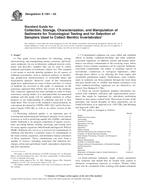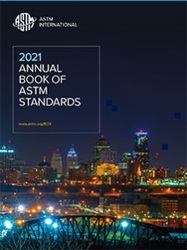
ASTM E1391-03
1.1 This guide covers procedures for obtaining, storing, characterizing, and manipulating marine, estuarine, and freshwater sediments, for use in laboratory sediment toxicity evaluations and describes samplers that can be used to collect sediment and benthic invertebrates (). This standard is not meant to provide detailed guidance for all aspects of sediment assessments, such as chemical analyses or monitoring, geophysical characterization, or extractable phase and fractionation analyses. However, some of this information might have applications for some of these activities. A variety of methods are reviewed in this guide. A statement on the consensus approach then follows this review of the methods. This consensus approach has been included in order to foster consistency among studies. It is anticipated that recommended methods and this guide will be updated routinely to reflect progress in our understanding of sediments and how to best study them. This version of the standard is based primarily on a document developed by USEPA (2001 (1)) and by Environment Canada (1994
1.2 Protecting sediment quality is an important part of restoring and maintaining the biological integrity of our natural resources as well as protecting aquatic life, wildlife, and human health. Sediment is an integral component of aquatic ecosystems, providing habitat, feeding, spawning, and rearing areas for many aquatic organisms (MacDonald and Ingersoll 2002a,b (3)(4)). Sediment also serves as a reservoir for contaminants in sediment and therefore a potential source of contaminants to the water column, organisms, and ultimately human consumers of those organisms. These contaminants can arise from a number of sources, including municipal and industrial discharges, urban and agricultural runoff, atmospheric deposition, and port operations.
1.3 Contaminated sediment can cause lethal and sublethal effects in benthic (sediment-dwelling) and other sediment-associated organisms. In addition, natural and human disturbances can release contaminants to the overlying water, where pelagic (water column) organisms can be exposed. Sediment-associated contaminants can reduce or eliminate species of recreational, commercial, or ecological importance, either through direct effects or by affecting the food supply that sustainable populations require. Furthermore, some contaminants in sediment can bioaccumulate through the food chain and pose health risks to wildlife and human consumers even when sediment-dwelling organisms are not themselves impacted (Test Method E 1706).
1.4 There are several regulatory guidance documents concerned with sediment collection and characterization procedures that might be important for individuals performing federal or state agency-related work. Discussion of some of the principles and current thoughts on these approaches can be found in Dickson, et al. Ingersoll et al. (1997
1.5 This guide is arranged as follows:
| Section | |
| Scope | |
| Referenced Documents | |
| Terminology | |
| Summary of Guide | |
| Significance and Use | |
| Interferences | |
| Apparatus | |
| Safety Hazards | |
| Sediment Monitoring and Assessment Plans | |
| Collection of Whole Sediment Samples | |
| Field Sample Processing, Transport, and Storage of Sediments | |
| Sample Manipulations | |
| Collection of Interstitial Water | |
| Physico-chemical Characterization of Sediment Samples | |
| Quality Assurance | |
| Report | |
| Keywords | |
| Description of Samplers Used to Collect Sediment or Benthic Invertebrates |
1.6 Field-collected sediments might contain potentially toxic materials and should thus be treated with caution to minimize occupational exposure to workers. Worker safety must also be considered when working with spiked sediments containing various organic, inorganic, or radiolabeled contaminants, or some combination thereof. Careful consideration should be given to those chemicals that might biodegrade, volatilize, oxidize, or photolyze during the exposure.
1.7 The values stated in either SI or inch-pound units are to be regarded as the standard. The values given in parentheses are for information only.
1.8 This standard does not purport to address all of the safety concerns, if any, associated with its use. It is the responsibility of the user of this standard to establish appropriate safety and health practices and determine the applicability of regulatory requirements prior to use. Specific hazards statements are given in Section 8.
Product Details
- Published:
- 11/10/2003
- Number of Pages:
- 93
- File Size:
- 1 file , 2.1 MB
- Redline File Size:
- 2 files , 3.8 MB

